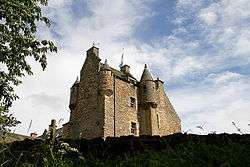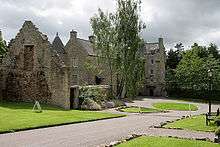Ferniehirst Castle
| Ferniehirst Castle | |
|---|---|
| South of Jedburgh, Scotland | |
 Ferniehirst Castle, keep | |
 Ferniehirst Castle | |
| Coordinates | 55°27′16″N 2°33′04″W / 55.45444°N 2.55111°WCoordinates: 55°27′16″N 2°33′04″W / 55.45444°N 2.55111°W |
| Site information | |
| Owner | Lord Ralph Kerr |
| Open to the public | Yes (July) |
| Site history | |
| Built | 1470 |
| Built by | Clan Kerr |
| In use | Residential |
| Battles/wars | occupied by the English in 1547-49 during the Rough Wooing |
Ferniehirst Castle (sometimes spelt Ferniehurst) is an L-shaped construction on the east bank of the Jed Water, about a mile and a half south of Jedburgh, in the Scottish Borders area of Scotland, and in the former county of Roxburghshire. It is an ancient seat of the Clan Kerr, and after a period of institutional use it was restored for residential use by Peter Kerr, 12th Marquess of Lothian, in the late 20th century.
History

Sixteenth-century conflict
The original castle, built by the Ker (or Kerr) family around 1470, was occupied by English forces in 1547, during the war of the Rough Wooing. The English were dislodged by a force of Sir John Ker's clansmen, and the Earl of Huntly reinforced by André de Montalembert and French auxiliaries led by Captain Pierre Longue in February 1549. The gate was fired, then Montalembert d'Essé brought more artillery and the soldiers set about the wall with picks and mattocks. The French soldier Jean de Beaugué described the recapture and the fate of the English captain and garrison,[1] and the aristocrat and priest Alexander Gordon wrote an eyewitness account.[2] An English army led by the Duke of Rutland recaptured the castle in June 1549, but the war was nearly over.[3]
Ferniehirst was damaged by an English retaliatory raid in 1570, after Sir Thomas Ker had raided northern England, and again in 1573 by Queen Elizabeth's army on their way to Edinburgh Castle.[4] James VI attacked the castle in 1593 as the Kers had assisted Francis Stewart, 1st Earl of Bothwell, who had conspired against the king. The Kers were for a long period Wardens of the Middle and East Marches. As the building had been undermined, reconstruction of the castle began in 1598.
Later and recent uses
The castle was unused in the 18th century, and re-roofed and repaired circa 1830, with a further major restoration of a part of it in 1890. It was used as a Scottish Youth Hostels Association hostel from 1934 to 1984, apart from during the Second World War, when it was requisitioned as a billet for troops. In 1988 major repairs, restoration, and alterations were carried out by Peter Kerr, 12th Marquess of Lothian, and the castle is once again a private home. It is currently used by his second son, Lord Ralph Kerr, who also owns Melbourne Hall in Derbyshire, and is the heir presumptive to the marquessate as his brother the 13th Marquess (politician Michael Ancram) has no sons. The castle is open to the public during July. It is a category A listed building.[5]
The Ker Chapel, dating from the 17th century, is part of the property. Probably originally a mortuary chapel, it was re-roofed in 1938 and had restrained conversion and repair in 1988. It is now in use as a visitor centre and is also a category A listed building.[6]
Description

The shorter arm of this L-plan fortalice is the 16th-century tower, containing the stair turret. The stair is in a spiral, corbelled out in the angle: apparently more for elegance than for necessity. There are many shot-holes, allowing a wide angle for musket fire, and of the more restricted shut-holes used for ventilation.
Ferniehirst also has a romantic array of conically capped corner turrets. These - known as studies - are not primarily defensive: they open from the rooms of the upper floor. There is some renaissance decoration around the windows and doors. The castle is approached through a classically styled archway.
See also
References
- ↑ Beaugué, Jean de (1707). History of the Campaigns of 1548 and 1549. pp. 92–96.
- ↑ Cameron, Annie, I., ed., Scottish Correspondence of Mary of Lorraine, SHS (1927), pp.286-290, Gordon's account differs from de Beaugué's over some details.
- ↑ Merriman, Marcus, The Rough Wooings, Tuckwell (2000), 140.
- ↑ Calendar of State Papers Scotland, vol. 5, HMSO (1907), 161, Ferniehirst to Mary, Queen of Scots, 8 July 1575.
- ↑ "Ferniehurst Castle, Listed Building". Historic Environment Scotland.
- ↑ "Ferniehurst Castle Visitor Centre (former chapel), Listed Building". Historic Environment Scotland.
- Fenwick, Hugh, Scotland’s Castles, Robert Hale, 1976.
- Keay, John & Julia (editors), Collins Encyclopedia of Scotland, HarperCollins, 1994.
- Kerr, Anthony, Ferniehirst Castle, Scotland's Frontier Stronghold, Kelso (1985)
- Coventry, Martin, The Castles of Scotland, Goblinshead, 2001,
- Strang, Charles Alexander, Borders and Berwick, The Rutland Press, 1994, p. 130, ISBN 1-873190-10-7
- Canmore record of Ferniehirst Castle
- Beaugué, Jean de (1830). "10". Histoire de la guerre d'Écosse pendant les campagnes 1548 et 1549. 3. Maitland Club, Edinburgh. pp. 101–103.
External links
| Wikimedia Commons has media related to Ferniehirst Castle. |